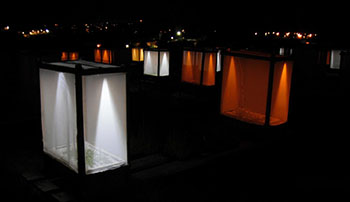
One study by Exeter scientists looked at ecosystem impacts of light pollution by exposing small grassland plots to white and amber artificial lighting. [Image: Jon Bennie/University of Exeter]
One of the themes of the International Year of Light 2015—a comprehensive celebration of light’s positive role in science, technology and art—is the bad things that can happen when there’s too much of the stuff. The problem of light pollution usually focuses on the havoc that human-created light, leaking into the night sky, can wreak for astronomers and astrophysicists, who rely on dark skies to do their work. But two recent studies from the University of Exeter, U.K., examined another aspect of light pollution: its impact on plant and animal species here on earth.
One of the two Exeter studies (Philos. Trans. R. Soc. London Ser. B, doi: 10.1098/rstb.2014.0124), led by Fiona Mathews (along with colleagues from the organization Bat Conservation Ireland), focused on the effects of street lighting on the behavior of bats, which constitute nearly a third of all nocturnal mammalian species. It’s been generally assumed that street lighting, which causes clouds of insects to congregate around the lit area, is beneficial to bats by creating a rich hunting ground for their favorite food. (Indeed, in the U.K., lighting has been cited as one positive form of habitat management for bat populations.)
Mathews and her colleagues surveyed bat populations and bat calls at 600 locations across Britain and Ireland, and found that the links between bat activity and street lighting were tenuous at best. “What our work shows,” says Mathews, “is that [bats] are actually usually just as active, if not more so, in adjacent dark areas.” The work speculated that while bats—known primarily for their echolocation abilities—actually have fairly well developed vision for low-light conditions, bright street lighting may actually dazzle them, compromising their ability to locate prey and navigate effectively and potentially causing other downstream ecosystem complications.
The second study (Philos. Trans. R. Soc. London Ser. B, doi: 10.1098/rstb.2014.0131), from a team of scientists at Exeter’s Environment and Sustainability Institute, focused in more detail on such possible ecosystem effects—in particular, on light pollution’s potential to disrupt natural food webs. The team set up small artificial grassland plots, complete with a suite of small herbivores (pea aphids) and prey (ladybird beetles). The scientists then exposed the plots to white light similar to new commercial LED street lighting and to amber light simulating more common sodium street lights, and compared the results against naturally lit control plots.
The team found that the artificially lit plots showed significantly lower populations of herbivores than did the control plots, with the effect especially pronounced in the amber-lit experiments. The cause did not appear to be driven from the top down—e.g., by increased predation from the ladybugs. Instead, the artificial lighting appears to have disrupted the flowering cycle of the bird’s-foot trefoil, the plant species within the plots that constituted the aphids’ principal food source. The decrease in flower density for the trefoil, in a cascading bottom-up effect, in turn led to thinning of the aphid population. Keven Gaston, the Exeter ESI’s director, suggested that these findings “reveal how profound the impacts of artificial night time lighting can be on even simple communities of organisms.”
The two papers are part of a thought-provoking theme issue of Philosophical Transactions B on “The biological impacts of artificial light at night.”
